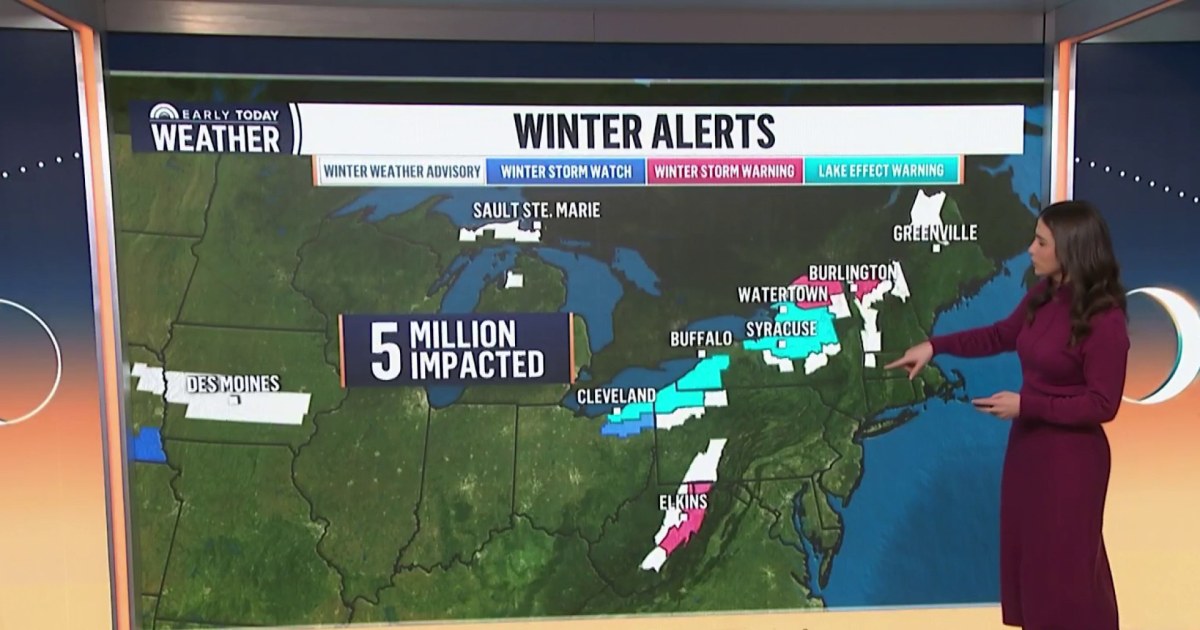Winter Warnings: How 5 Million People Brace for a Frigid 2025
As the new year unfolds, winter weather alerts are echoing across the nation, prompting over 5 million individuals to prepare for a particularly harsh 2025. With forecasts predicting plummeting temperatures, heavy snowfall, and icy conditions, experts are urging communities to prioritize safety and preparedness. This article delves into the challenges posed by extreme winter weather, shares expert advice on how to cope with the cold, and offers a glimpse into the resilience of those braving the elements.
The Scope of the Cold: Understanding Winter Warnings
Winter warnings are more than just advisories; they are vital signals that inform the public about potential hazards that could impact daily life. The National Weather Service (NWS) has been issuing winter weather alerts that encompass a range of conditions, including:
- Winter Storm Warnings: Indicating significant snowfall or ice accumulation.
- Wind Chill Warnings: Alerting individuals to dangerously low temperatures combined with wind, which can lead to frostbite or hypothermia in minutes.
- Blizzard Warnings: Signifying severe conditions with sustained winds and heavy snowfall that can create whiteout conditions.
This year, the number of people affected by these warnings has surged, with over 5 million residents in various states preparing for an onslaught of cold. This uptick can be attributed to shifting climate patterns and more frequent extreme weather events, prompting communities to reassess their preparedness strategies.
Preparing for the Chill: Expert Insights
As temperatures drop and winter storms loom, experts recommend a series of practical measures to ensure safety and comfort:
- Home Readiness: Ensure your home is well-insulated. Seal any gaps around windows and doors to prevent drafts. Consider investing in a programmable thermostat to maintain a consistent temperature.
- Emergency Kits: Assemble an emergency kit that includes essentials such as non-perishable food, water, flashlights, batteries, first-aid supplies, and medications. Regularly check and replenish your supplies.
- Heating Systems: Have your heating system inspected and serviced before the cold sets in. Keep space heaters away from flammable materials, and never leave them unattended.
- Communication Plans: Establish a communication plan with family and friends. Share your location and discuss meeting points in case of emergencies.
Dr. Emily Thompson, a climatologist at the National Weather Center, emphasizes the importance of local resources: “Communities should stay connected with local weather reports and heed any warnings. It’s vital to understand the risks associated with winter weather, particularly in areas prone to severe conditions.”
Staying Safe on the Roads
Winter travel can be treacherous, with icy roads and limited visibility. Here are some key tips for safe driving during winter storms:
- Winterize Your Vehicle: Ensure your vehicle is equipped with winter tires, a full gas tank, and a properly functioning battery.
- Emergency Kit: Keep an emergency kit in your car that includes blankets, snacks, water, and a shovel.
- Drive Cautiously: Reduce speed and increase following distance. Avoid sudden movements to maintain control of your vehicle.
- Stay Informed: Check weather reports before heading out and adjust your travel plans as necessary.
Many individuals have shared personal accounts of navigating winter storms. For instance, John Miller, a seasoned truck driver, recounts, “Every year we face challenges, but preparation is key. I always make sure my truck is ready and that I monitor conditions closely.”
Community Resilience: A Collective Effort
As the harsh winter approaches, communities across the country are banding together to support one another. Local organizations are stepping up to provide resources, including:
- Heating Centers: Designated warming centers for those without adequate heating in their homes.
- Food Drives: Initiatives to collect and distribute food to families in need during the winter months.
- Volunteer Programs: Opportunities for community members to assist vulnerable populations, including the elderly and low-income families.
Maria Rodriguez, a community organizer, highlights the spirit of cooperation: “In winter, we see the best of humanity. Neighbors look out for each other, and local organizations ensure no one is left behind.”
Adapting to the New Normal
Climate change has altered winter weather patterns, leading to more intense storms and unpredictable conditions. As we brace for a frigid 2025, adapting to these changes becomes essential. This includes:
- Investing in Infrastructure: Cities are looking to improve snow removal and road maintenance to better handle severe winter conditions.
- Public Awareness Campaigns: Educating residents on winter safety and preparedness through workshops and informational sessions.
- Enhancing Emergency Services: Ensuring that first responders are equipped and trained to handle winter-related emergencies.
Experts agree that understanding the evolving climate and its implications for winter weather is critical. “We need to prepare for a future where severe winters may become more common,” says Dr. Thompson. “This means investing in our communities and ensuring everyone knows how to stay safe.”
Conclusion: Braving the Cold Together
As over 5 million people face the challenges of a frigid 2025, the importance of preparedness and community support cannot be overstated. From individual safety measures to collective resilience, every action counts in the battle against extreme winter conditions. While the cold may be daunting, the spirit of cooperation and preparedness shines brightly, reminding us that together, we can weather any storm.
As we move deeper into winter, let’s embrace the challenges with optimism, ensuring that we’re ready for whatever the season throws our way. Stay safe, stay warm, and look out for one another!
See more Your Daily Weather



